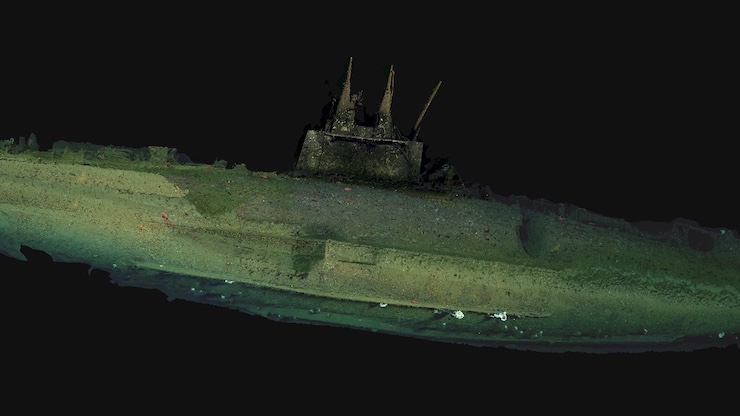
Image by Zoe Daheron, ©Woods Hole Oceanographic Institution
On the last Monday in May, Memorial Day, people across the nation honor any military personnel who died in service to the United States of America. Often, the days leading up to Memorial Day are also marked by special events to honor fallen veterans. On May 21, 2025, Woods Hole Oceanographic Institution (WHOI) announced a special project they had led that not only provides valuable research data, but also honored the lives of 19 naval sailors who died onboard the U.S. Navy submarine USS F-1.
On December 17, 1917, the submarine was performing a surface-level exercise off the coast of San Diego, CA, when it collided with its sister ship, the U.S. Navy submarine USS F-3. The F-1 sank within 10 seconds, while sailors on the F-3 were able to rescue 5 of the 24 crew members of the doomed ship. The wreckage of the F-1 was discovered in 1976, but technology was not yet available to properly image the ship.
WHOI has become a pioneer in the deployment of highly advanced underwater drones perfect for such missions. From February 24 to March 4, 2025, working in collaboration with the National Deep Submergence Facility (NDSF), National Science Foundation (NSF), Office of Naval Research (ONR), Naval History and Heritage Command (NHHC), the U.S. Navy, the University-National Oceanographic Laboratory System (UNOLS), and the National Oceanic and Atmospheric Administration (NOAA), WHOI used manned and unmanned technology to capture detailed images of the USS F-1 sitting approximately 400 meters below the ocean surface.
The mission was carried out from WHOI’s research vessel, the Atlantis, from which their human-occupied vehicle (HOV) Alvin, and autonomous underwater vehicle (AUV) Sentry, made several dives. The Alvin was used to provide dive training for WHOI scientists. The HOV, the same one famous for exploring the Titanic in 1986, is equipped with a range of camera systems that captured live and still images of the wreck. Meanwhile, the Sentry is one of WHOI’s most trusted and used research tools.
Sentry was first tested in 2006 and completed its first scientific mission in 2008. According to a WHOI fact sheet, the drone has completed more than 370 dives worldwide with nearly 5,020 hours in the water, covering 10,210 km. “Sentry carries a dual-frequency side-scan sonar system that operates at 120 kHz and 410 kHz and recently gained the ability to incorporate a dynamic focus side-scan sonar that operates at 850 kHz,” the fact sheet continues. “Sentry also carries high-performance still cameras. Data products from Sentry include side-scan sonar and sub-bottom profiles; multibeam maps, magnetic data, and photographs.”
The drone operates without a tether to a master ship. All of its missions are therefore preprogrammed to be carried out autonomously. Sentry can reach depths of 6,000 meters and is powered by 1,000 lithium-ion batteries, allowing it to remain in the water for upwards of 24 hours at a time. It has been used to collect data in the Gulf of Mexico’s Deepwater Horizon oil spill, assisted with the deployment of a connected seafloor observatory on the Juan de Fuca tectonic plate, and much more. Now, the drone has had the opportunity to bring some closure to the families of the victims of USS F-1.
Thousands of images were collected by the Alvin and Sentry vehicles. These images were then stitched together with AI software. “This wealth of data and imagery allowed the ocean imaging team at WHOI to reconstruct the F-1 submarine using photogrammetry, resulting in stunning 3-D models,” reads a statement from WHOI. When all the dives were completed, the collaborating teams held a small ceremony from the deck of the Atlantis, anchored above the wreck of the USS F-1.
Among the crew onboard the Atlantis was NHHC underwater archaeologist Brad Krueger. He reflected on how touching the memorial service was, during which a bell was rung 19 times as the names of each of the 19 sailors were called out. “It was an incredibly exciting and humbling experience to visit these historically significant wrecks and to honor the sacrifice of these brave American sailors,” he said. “History and archaeology are all about people, and we felt it was important to read their names aloud. The Navy has a solemn responsibility to ensure the legacies of its lost sailors are remembered.”
As we observe Memorial Day, projects like this remind us that honoring fallen service members goes beyond ceremonies, it includes preserving their stories, uncovering their final resting places, and ensuring their sacrifices are never forgotten. Through science, exploration, and remembrance, the legacy of the USS F-1 and her crew lives on beneath the waves, etched into both history and the hearts of a grateful nation.
|